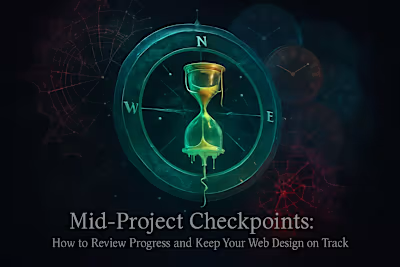Avoiding Scope Creep: How to Manage Web Design Project Changes

Avoiding Scope Creep: How to Manage Web Design Project Changes
What is Scope Creep and Why is it Harmful?
Defining Scope Creep
Common Causes of Scope Creep
The Impact on Timelines and Budgets
Proactive Strategies to Prevent Scope Creep
Create a Detailed Project Scope Document
Prioritize Features with a Phased Approach
Document Everything
How to Manage Change Requests Effectively
Implement a Formal Change Request Process
Analyze the Impact of Each Change
Get Written Approval for All Changes
Know When to Say No
Conclusion
References
Avoiding Scope Creep: How to Manage Web Design Project Changes
Scope creep—the silent expansion of a project's requirements—is one of the biggest threats to your timeline and budget. It often starts with a small request, but can quickly snowball, leading to delays and frustration. The best way to combat this is by having a clear process for managing changes. This starts with providing effective feedback to your designer and is reinforced by using robust collaboration tools to document everything.
Picture this: You've hired a web designer for a five-page website. Two weeks in, you ask for "just one more page." Then a contact form. Then a blog section. Before you know it, your simple website has morphed into something completely different. Your designer is stressed, you're over budget, and nobody's happy. Sound familiar? If you're planning to find a professional web designer, understanding how to manage project changes is crucial for success.
What is Scope Creep and Why is it Harmful?
Scope creep happens when new features or changes are added to a project without corresponding adjustments to time, budget, or resources. Understanding its causes and consequences is the first step toward preventing it.
Think of scope creep like renovating a kitchen. You start wanting new cabinets. Then you decide the countertops should match. Suddenly you're knocking down walls. What began as a simple update becomes a complete overhaul. The same thing happens in web design projects, and the results can be just as messy.
Defining Scope Creep
It's the process where a project's deliverables grow beyond what was originally agreed upon. This can range from adding a new page to completely changing a feature's functionality mid-project.
Let me give you a real example. Sarah hired a designer to create an online portfolio. The original scope included five pages: home, about, portfolio, services, and contact. Halfway through, she asked to add a blog. Then she wanted each portfolio item to have its own detailed page. What started as a five-page site ballooned into a 25-page project.
The tricky part? These changes often seem reasonable in isolation. Adding one blog post template doesn't sound like much. But when you multiply that by categories, tags, archives, and search functionality, you've essentially doubled the project scope.
Common Causes of Scope Creep
Scope creep often stems from a poorly defined initial scope, a lack of stakeholder consensus, or informal communication channels where small requests can easily be made and accepted without formal approval.
Vague project requirements are the biggest culprit. When you tell a designer you want "a modern website that converts visitors," you're leaving too much room for interpretation. What does modern mean to you? What specific conversion goals do you have? Without clear answers, both you and your designer are working with different visions.
Multiple decision-makers create another common pitfall. When the CEO, marketing manager, and sales director all have different ideas about what the website needs, changes multiply quickly. I've seen projects where each stakeholder added their "must-have" features without considering the cumulative effect.
Informal communication makes things worse. Those quick Slack messages saying "Hey, can we just add..." seem harmless. But they bypass the formal approval process. Soon, your designer is juggling dozens of small changes that add up to major scope expansion.
The Impact on Timelines and Budgets
Every change, no matter how small, requires time and resources. Unchecked scope creep inevitably leads to missed deadlines and budget overruns, which can strain the client-designer relationship.
Here's what many clients don't realize: adding a feature isn't just about building it. Your designer needs to:
Stop current work to assess the change
Redesign existing elements to accommodate it
Test how it affects other features
Update documentation
Potentially redo work that's already complete
A "simple" request to add social media integration might require redesigning the header, adjusting the mobile layout, and creating new icon styles. What seems like a one-hour task becomes a day of work.
The financial impact hits hard too. If your $5,000 project experiences 30% scope creep, you're looking at $1,500 in additional costs. That's assuming your designer charges for the extra work. Some absorb these costs to maintain the relationship, leading to resentment and burnout.
Proactive Strategies to Prevent Scope Creep
The best way to manage scope creep is to prevent it from happening in the first place. This involves meticulous planning and clear communication from the very beginning of the project.
Prevention beats cure every time. By investing time upfront in planning and documentation, you'll save yourself headaches, money, and strained relationships down the road. Let's look at three powerful strategies that successful projects use to keep scope creep at bay.
Create a Detailed Project Scope Document
The most critical step is to create a comprehensive project brief or Statement of Work (SOW) that clearly outlines all objectives, deliverables, features, and functionalities. This document should be signed by all stakeholders.
Your scope document is your project's constitution. It should answer every important question about what you're building. Start with the basics: How many pages? What functionality on each page? Which devices need to be supported? What browsers?
But don't stop there. Get specific about features. Instead of "contact form," specify:
Number of fields
Validation requirements
Where submissions go
Confirmation message details
Integration with email marketing tools
Include visual requirements too. How many design concepts will be presented? How many rounds of revisions are included? What about stock photos or custom graphics?
The magic happens when you also document what's not included. Explicitly state that blog functionality, e-commerce features, or multilingual support are out of scope. This prevents assumptions and gives you a reference point when new requests arise.
Prioritize Features with a Phased Approach
Divide the project into phases. Focus on launching the core, essential functionalities in Phase 1. Desirable but non-essential features can be added to a "Phase 2 Wish List" to be addressed after the initial launch.
Smart project planning recognizes that you can't have everything at once. By breaking your project into phases, you maintain momentum while keeping scope manageable.
Phase 1 should include your MVP (Minimum Viable Product). Ask yourself: What's the bare minimum needed to launch and start providing value? For an e-commerce site, that might be:
Product catalog
Shopping cart
Basic checkout
Essential pages (shipping, returns, about)
Phase 2 can add the nice-to-haves:
Wishlist functionality
Product reviews
Advanced filtering
Loyalty program integration
This approach has multiple benefits. You get to market faster with Phase 1. You can gather real user feedback before investing in Phase 2 features. And you maintain a clear boundary between what's in the current scope and what's planned for later.
I've seen this save countless projects. When a stakeholder says "We need live chat support," you can respond with "Great idea! Let's add that to Phase 2 so we don't delay our launch."
Document Everything
Keep a written record of all discussions, decisions, and approvals. This creates a clear audit trail and ensures that everyone is aligned on what has been agreed upon, preventing misunderstandings down the road.
Documentation isn't sexy, but it's your safety net. Every meeting, every decision, every change should be captured in writing. This isn't about being paranoid—it's about clarity and professionalism.
Meeting notes should be shared within 24 hours. Include:
Attendees
Decisions made
Action items with owners
Next steps
Email confirmations turn verbal agreements into written records. After a phone call where changes were discussed, send a quick email: "Just to confirm our conversation, we agreed to postpone the newsletter integration to Phase 2 and focus on launching the core site by March 15th."
Use a central repository for all project documentation. Whether it's Google Drive, Notion, or a project management tool, everyone should know where to find the latest scope document, meeting notes, and decisions.
How to Manage Change Requests Effectively
Change is sometimes inevitable. A great idea might emerge mid-project. The key isn't to forbid change, but to manage it through a formal process that assesses its impact.
Let's be realistic—no project runs exactly as planned. Market conditions shift. New opportunities arise. Better ideas emerge. The goal isn't to become inflexible, but to handle changes professionally so they enhance rather than derail your project.
Implement a Formal Change Request Process
Establish a clear procedure for submitting change requests, which should always be in writing. A change request form should detail the proposed change and why it's needed.
A formal process transforms chaos into order. Instead of random requests flying in from all directions, you create a single, clear path for proposing changes.
Your change request form should capture:
Description of the requested change
Business justification (why is this needed?)
Priority level (critical, important, nice-to-have)
Requested completion date
Potential impact if not implemented
Make the process accessible but not too easy. If someone has to fill out a form, they'll think twice about whether that change is really necessary. This natural friction filters out impulsive requests.
Set expectations about response time. Let stakeholders know that change requests will be reviewed weekly (or whatever timeline works for your project). This prevents the expectation of immediate action and gives your designer time to properly assess each request.
Analyze the Impact of Each Change
When a change is requested, the designer should assess its impact on the project's timeline, budget, and resources. This analysis must be presented to the client before the change is approved.
Impact analysis is where reality meets desire. Your designer needs time to thoroughly evaluate how a change affects the entire project ecosystem.
A proper impact analysis includes:
Hours required to implement
Effect on project timeline
Additional costs
Technical dependencies
Risk to existing functionality
Required testing time
For example, adding a customer login area isn't just about creating login screens. It requires:
User database design
Password security implementation
Password reset functionality
Session management
Privacy policy updates
Testing across all browsers
Present this analysis clearly. Use simple language and concrete numbers. "Adding customer accounts will require 40 additional hours of development, push the launch date back two weeks, and add $3,200 to the project cost."
Get Written Approval for All Changes
No work on a change should begin until the client has formally approved the adjustments to the scope, timeline, and budget in writing. This maintains accountability and ensures transparency.
Written approval is your insurance policy. It protects both you and your designer from misunderstandings and disputes down the road.
The approval should explicitly state:
What change is being approved
New timeline implications
Additional costs
Any trade-offs (features being removed or postponed)
Signature and date
Don't let informal approvals slide. That enthusiastic "Yes, let's do it!" in a meeting needs to be followed by written confirmation. Create a simple template that can be quickly customized for each change request.
Consider using digital tools for faster approval. DocuSign, HelloSign, or even a simple email confirmation can work. The key is having a clear record that everyone agreed to the change and its implications.
Know When to Say No
Sometimes, a change request may be detrimental to the project's goals or timeline. It's important to have an open conversation about whether the proposed change adds real value or if it should be deferred to a future phase.
Saying no isn't about being difficult. It's about protecting the project's success. Some changes, while interesting, can derail your core objectives or push your launch date beyond a critical deadline.
Red flags that suggest you should say no:
The change contradicts your core project goals
It would delay launch past a crucial business deadline
The cost-benefit ratio doesn't make sense
It introduces significant technical complexity
It's driven by personal preference rather than user needs
Frame your "no" constructively. Instead of flat rejection, try: "I understand why this feature seems valuable. However, implementing it now would delay our launch by three weeks, missing our peak season. Could we revisit this for Phase 2?"
Offer alternatives when possible. If someone wants complex animation that would blow the budget, suggest simpler transitions that achieve a similar effect. If they want a custom CRM integration, propose starting with a simple form that exports to CSV.
Remember, you're the client. While your designer's expertise matters, you ultimately decide what's best for your business. A good designer will respect thoughtful decisions about scope, even when it means saying no to exciting features.
Conclusion
Managing scope creep isn't about being rigid or stifling creativity. It's about creating a framework that allows for thoughtful changes while protecting your project's success. By establishing clear documentation, implementing formal change processes, and maintaining open communication, you transform potential chaos into controlled evolution.
The strategies we've covered—from detailed scope documents to formal change requests—might seem like extra work upfront. But they're investments that pay dividends throughout your project. They prevent those painful moments when you realize you're three months behind schedule and thousands over budget.
Remember, the best projects aren't necessarily those that stick rigidly to the original plan. They're the ones that adapt intelligently to new information while maintaining focus on core objectives. With these tools in your arsenal, you're ready to navigate the inevitable changes that arise in any web design project.
Start your next project right. Take time to define clear scope. Set up your change management process before you need it. And maintain the kind of transparent communication that turns potential conflicts into collaborative solutions. Your future self—and your designer—will thank you.
References
Like this project
Posted Jun 30, 2025
Scope creep can derail your project's timeline and budget. Learn how to define your project scope, manage change requests, and keep your web design project on track.











